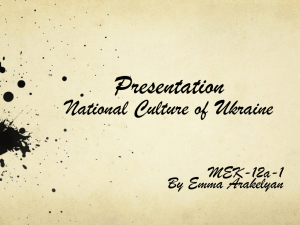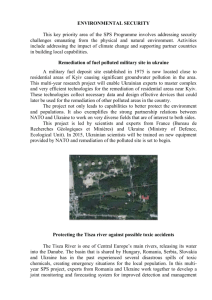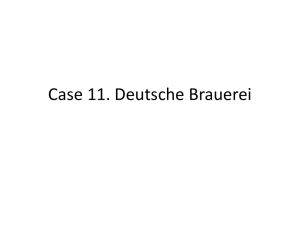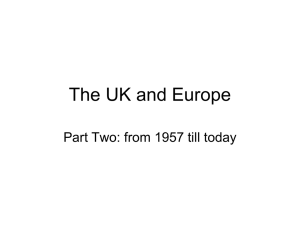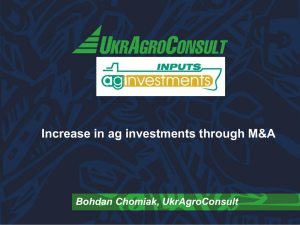WATER MANAGEMENT IN WESTERN UKRAINE
advertisement
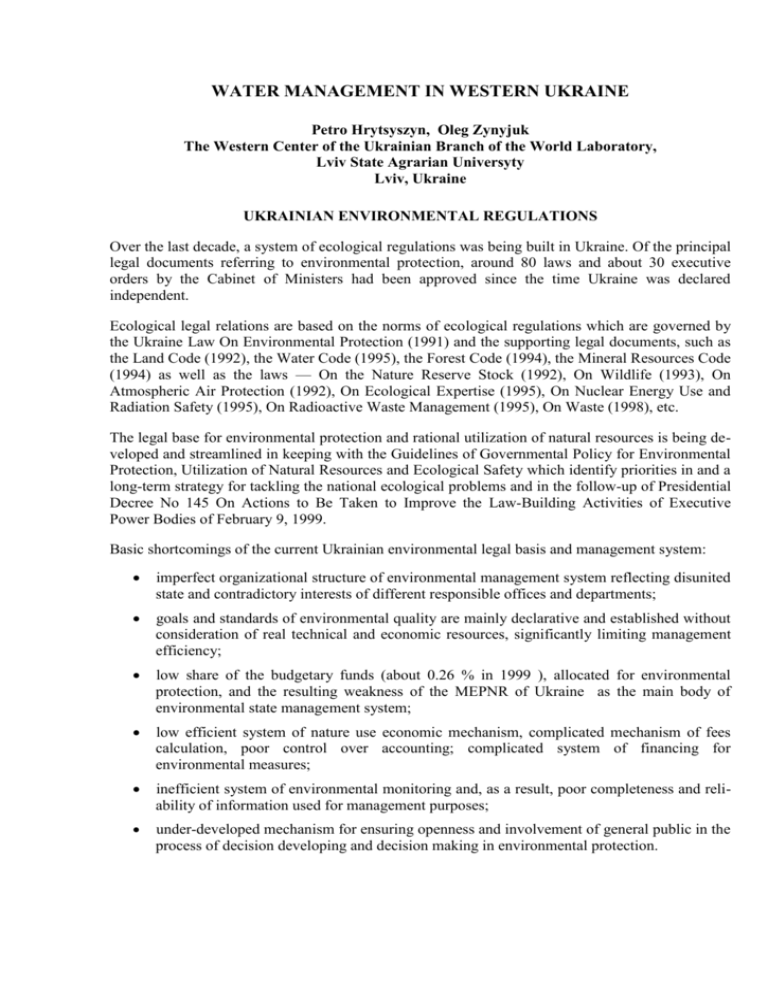
WATER MANAGEMENT IN WESTERN UKRAINE Petro Hrytsyszyn, Oleg Zynyjuk The Western Center of the Ukrainian Branch of the World Laboratory, Lviv State Agrarian Universyty Lviv, Ukraine UKRAINIAN ENVIRONMENTAL REGULATIONS Over the last decade, a system of ecological regulations was being built in Ukraine. Of the principal legal documents referring to environmental protection, around 80 laws and about 30 executive orders by the Cabinet of Ministers had been approved since the time Ukraine was declared independent. Ecological legal relations are based on the norms of ecological regulations which are governed by the Ukraine Law On Environmental Protection (1991) and the supporting legal documents, such as the Land Code (1992), the Water Code (1995), the Forest Code (1994), the Mineral Resources Code (1994) as well as the laws — On the Nature Reserve Stock (1992), On Wildlife (1993), On Atmospheric Air Protection (1992), On Ecological Expertise (1995), On Nuclear Energy Use and Radiation Safety (1995), On Radioactive Waste Management (1995), On Waste (1998), etc. The legal base for environmental protection and rational utilization of natural resources is being developed and streamlined in keeping with the Guidelines of Governmental Policy for Environmental Protection, Utilization of Natural Resources and Ecological Safety which identify priorities in and a long-term strategy for tackling the national ecological problems and in the follow-up of Presidential Decree No 145 On Actions to Be Taken to Improve the Law-Building Activities of Executive Power Bodies of February 9, 1999. Basic shortcomings of the current Ukrainian environmental legal basis and management system: imperfect organizational structure of environmental management system reflecting disunited state and contradictory interests of different responsible offices and departments; goals and standards of environmental quality are mainly declarative and established without consideration of real technical and economic resources, significantly limiting management efficiency; low share of the budgetary funds (about 0.26 % in 1999 ), allocated for environmental protection, and the resulting weakness of the MEPNR of Ukraine as the main body of environmental state management system; low efficient system of nature use economic mechanism, complicated mechanism of fees calculation, poor control over accounting; complicated system of financing for environmental measures; inefficient system of environmental monitoring and, as a result, poor completeness and reliability of information used for management purposes; under-developed mechanism for ensuring openness and involvement of general public in the process of decision developing and decision making in environmental protection. WATER MANAGEMENT IN UKRAINE In Western Ukraine we tried to compare the Ukrainian and EU water-related legislation, using the following items: Directive on Urban Wastewater Treatment; Directive on Requirements for Surface Water Quality Designed for Abstraction of Drinking Water; Directive on Quality of Water, Intended for Human Consumption; Directive on Quality of Water, Intended to Support Fish Life; Directive on Pollution of Water, caused by Discharge of Dangerous Substances. ANALYSIS AND COMPARISON OF STRUCTURE OF WATER LEGISLATION OF UKRAINE AND EU As it was historically formed, only one law was acting for regulation of water related relationships in Ukraine - the Water Code of Ukraine. Prior to the independence of Ukraine its general provisions completely coincided with those of the Principles of water legislation of the Soviet Union and its Republics, enacted on September 1, 1971. The new Water Code of Ukraine, enacted on June 6, 1995, has some significant differences in comparison to its predecessor, but even now it is the only legal document in the area of water protection and water use and recreation of water resources, of the level, corresponding to the level of the State Law. At the same time there also exists the ever expanding framework of regulations and other normative acts, approved by the State governmental authorities, which actually to the great extent perform legislative functions. The normative acts that perform legislative functions, in addition to the Water Code of Ukraine: Regulation on Protection of Surface, Marine and Ground Waters; Normative Requirements to content and properties of water in water bodies used as sources of industrial and drinking water as well as water for cultural and domestic and fishery purposes; Standards for maximum permissible concentrations of pollutants for the above water bodies; Regulation for development and approval of the standards for maximum permissible discharge of pollutants and list of pollutants, discharge of which is subject to standard; Regulation for the State water monitoring; other documents. There is so far no single collection of all those documents which regulate water related relationships in Ukraine or practically appropriate summaries of the complex normative acts relating to water resources usage and protection. Therefore it is now difficult to determine their general structure. The Verkhovna Rada of Ukraine is according to the Water Code of Ukraine (Article 7) responsible for legislative regulation of water related relations and determination of the basic principles of the State police in this area. The only document of such legislative regulation is the Water Code of Ukraine itself, norms of which are mostly not the ones of direct action, and its formulation and approval as the norms of 2 direct action is delegated to the different executive authorities, starting with the Cabinet of Ministers of Ukraine (Articles 19, 20, 21, 25, 26, 27, 28, 36, 37, 38, 39, 40, 62, 68, 72,73,74,75,93, 102). On the other hand, in the EU the more expanded system for legislative regulation of water related relationships has established since 1972, which consists of 10 Directives approved by the Council, directly relating to the water management issues, as well as 9 normative acts (groups thereof), tightly connected with them. Besides, the EC has the legislation, regulating classification, marking and assessment of risk of chemicals (6 basic legislative acts), objective of which is assessment of risk and regulation of industrial substances, which can potentially be polluting. SUMMARY LIST OF LEGISLATIVE ACTS OF WATER RELATED LEGISLATION OF UKRAINE IN BRACKETS: The Water Code of Ukraine (6/6/95) Regulation on Protection of Surface Water (typical provisions) (1/3/91) Regulation on Protection of Surface Waters from Pollution by Wastewater (draft, 3/4/97) Regulation on Protection of Internal Sea Waters and Territorial Sea from Pollution and Littering (29/2/96) Regulation on Protection of Groundwater (draft, 5/12/96) Hygienic Requirements to Content and Properties of Waters at Sites of Industrial and Drinking, Cultural and Domestic Water Use (14 parameters) (4/7/88) The Maximum Permissible Concentrations of Hazardous Substances in Water of Water Bodies, Used for Industrial, Drinking, Cultural and Domestic Water Use (1345 substances) (4/7/88) General Requirements to Content and Properties of Waters in Water Courses and Water Bodies at Sites of Fishery Water Use (11 parameters) (1/3/91) List of Maximum Permissible Concentrations (MPC) and Approximately Safe Impact Levels (ASIL) of Hazardous Substances on Water of Fishery Water Bodies (relating to Regulation on Protection of Surface Waters. 1991, 1072 MPC and 48 ASIL) (31/12/92) Procedure for Development and Approval of Maximum Permissible Discharges of Pollutants (11/9/96) List of Pollutants, Discharge of Which Is Subject to Regulation (3 lists, total of 297 substances) (11/9/96) Regulation on the State Water Monitoring (20/7/96) Environmental Assessment of Water Quality in Surface Waters and Estuaries of Ukraine. Guidelines (28/12/94) Biological Testing and Determination of Acute Lethal Toxicity Levels of Wastewater Discharged into Water Bodies. Guidelines (30/5/95) Instruction on Procedure for Development and Approval of Maximum Permissible Discharges (MPD) of Substances into Water Bodies with Wastewater (22/12/94) Procedure for Levying Charges for Special Use of Water Resources and Normative Tariffs for the Special Water Uses (8/2/94, 8/2/97) GOST (State standard) Control 2874-82 Drinking Water. Hygienic Requirements and Quality 3 and EU WATER RELATED DIRECTIVES AND GUIDELINES: Framework Directive EC Water Policy Principal Acts of Water Related Legislation On Water Quality in Surface Waters used as Sources of Drinking Water (75/440/EEC) On Quality of Bathing Water (76/160/EEC) On Pollution Caused by Certain Dangerous Substances, Discharged into Water Bodies (76/464/EEC) Council Decision Setting Forth the Procedure for Exchange of Information on Surface Water Quality (77/795/EEC) On Surface Water Quality Necessary to Support Fish Life (78/659/EEC) On Shellfish Water Quality (79/923/EEC) On Protection of Groundwater from Pollution by Certain Dangerous Substances (80/68/EEC) On Water Quality for Human Consumption (80/778/EEC, COM(94), 612 final - 95/10 (SYN)) On Urban Wastewater Treatment (91/271/EEC) On Protection of Waters from Pollution by Nitrates from Agricultural Sources (91/676/EEC) EU legislation, tightly connected with water related legislation Directive on Wastewater Sludge (86/278) Directive on Reporting (91/692/EEC) Directive on Integrated Pollution Prevention and Control (96/61/EC) Directives on Means for Protection of Plants (91/414/EEC, COM(93)351, COM(95)387 COD 465) Directive on Detergents (73/404/EEC, 73/405/EEC) Directive on Substantial Accidents (Cebeso) (82/501/EEC) Directives for Protection of Biodiversity (92/43/EEC, 79/409/EEC) Assessment of Environmental Impact (for jjew Projects) (85/37/EEC) Legislation on Classification and Labeling of Chemicals and Risk Assessment (67/548/EEC, 793/93/EEC, 78/631/EEC, 88/379/EEC, 93/67/EEC, 1488/94) As seen from above, water related legislation in Ukraine and EC are substantially different in their structures. The regulated objects are more or less similar only for 7 Ukrainian and 6 EC regulatory documents. These are documents 5 and 8 (the first number stands for Ukrainian, the second one for the EC document); 6,7 and 2,3; 8,9 and 6; 11 and 4; 17 and 9. In some documents the regulated objects overlap to some extent (1 and 1; 2,3,4,5 and 1; 12 and 5,13). The rest of the documents have very little in common. 4 CONCLUSIONS: Harmonization of Ukrainian water protection and economic water use legislation with the corresponding EC legislation requires undertaking the following steps: Development of the draft Amendments to the Water Code of Ukraine aimed at increasing the number of direct action norms in the Code an taking into account a series of advanced regulatory provisions of the EC legislation; Development of the specific Laws and Regulations of Ukraine; Development of basin-wide approaches to water-related issues management; Development of the system of water-related issues monitoring. In my report I have used the materials of State department of Environmental Management and Natural Resources in Lviv and Volyn oblast of the Western Ukraine. 5

